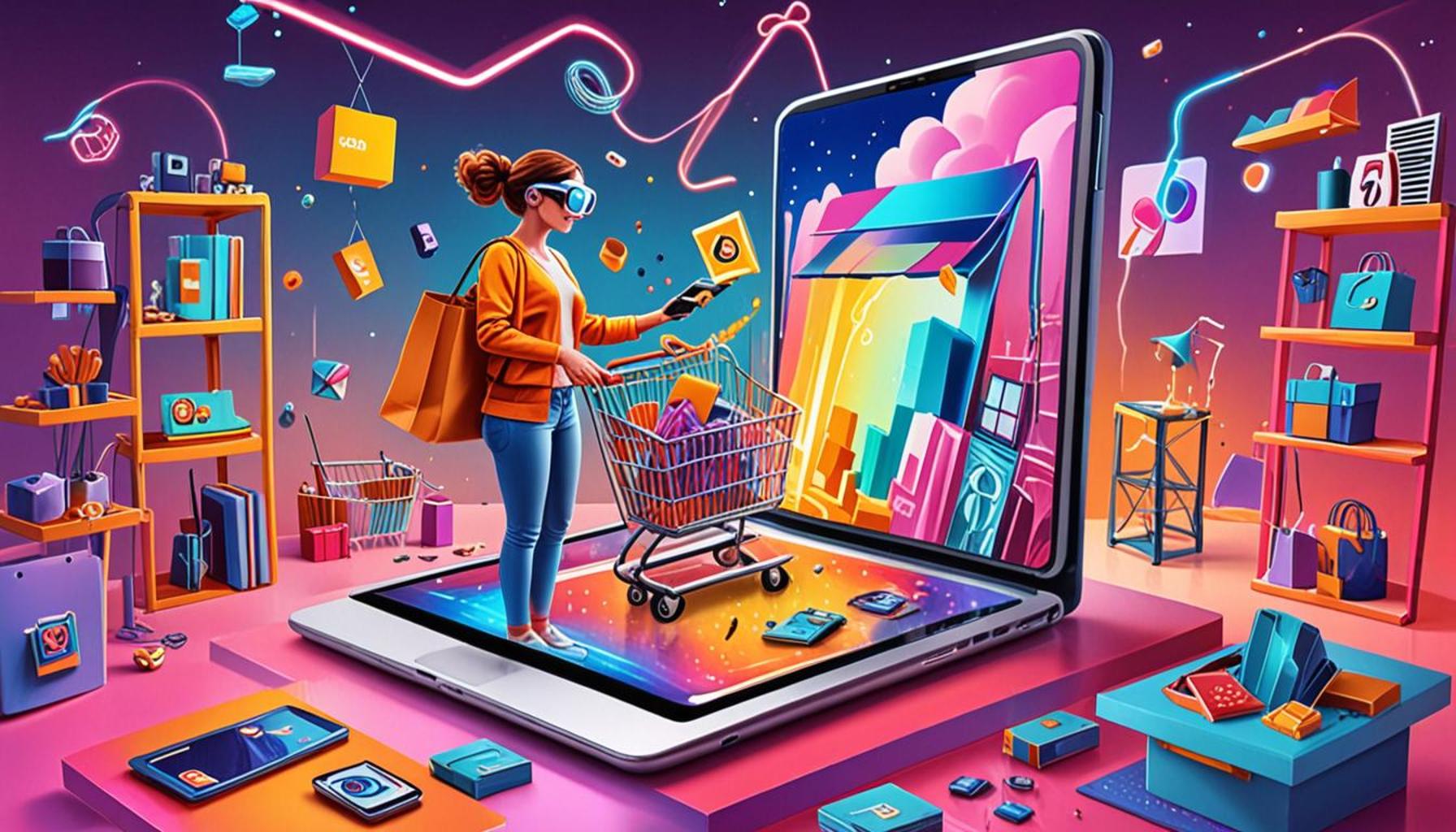The Impact of Augmented Reality on Online Shopping Experiences

The Rise of Augmented Reality in Retail
As we navigate through an increasingly digital world, the convergence of technology and retail is revolutionizing consumer shopping behavior. One of the most groundbreaking innovations enhancing this transformation is Augmented Reality (AR). AR technology creates immersive experiences that extend well beyond traditional online shopping methods, offering consumers a uniquely engaging way to explore and interact with products.
This innovative technology directly responds to the evolving demands of shoppers who crave more dynamic and interactive experiences. Consider the following compelling features that AR brings to the online shopping landscape:
- Virtual Try-Ons: Many retailers now offer features that allow customers to “try on” items such as clothing, shoes, or makeup in real time. For instance, companies like Sephora and Warby Parker have developed AR apps that enable users to see how a lipstick shade or a pair of glasses looks, directly from their smartphones. This not only enhances the shopping experience but also empowers consumers to make informed decisions without the need for physical trials.
- Product Visualization: Furniture retailers like IKEA are leveraging AR to allow customers to visualize how furniture pieces will look in their own homes. Through applications such as the IKEA Place app, users can place 3D models of furniture in their actual living spaces, adjusting size and orientation, which helps them make better choices regarding aesthetics and fit before purchase.
- Interactive Experiences: AR transforms ordinary product descriptions into engaging demonstrations. For example, brands like Nike are using AR to create interactive shoe demos where potential buyers can view the product from every angle, seeing features like cushioning technology in action. Such experiential marketing tactics help educate consumers about the products more effectively than static images or text descriptions.
The benefits of AR are evident. According to recent studies, 74% of consumers express frustration when unable to physically interact with a product prior to purchasing. This sentiment underscores the vital role AR plays in alleviating uncertainty regarding product quality and fit. By merging the digital and physical shopping experiences, AR effectively bridges gaps and simplifies the decision-making process for shoppers.
Beyond enhancing individual shopping experiences, AR significantly impacts consumer behavior and sales outcomes. Retailers incorporating AR technology have reported increases in conversion rates, as customers are more likely to complete transactions when they feel confident about their choices. Moreover, AR creates brand loyalty, as engaging and innovative shopping experiences tend to foster positive connections between consumers and brands.
As we explore the implications of AR in retail, it’s clear that this technology is not merely a passing trend. It is pivotal in shaping the future of shopping, establishing new norms that will redefine consumer expectations and experiences. As retailers continue to innovate, the role of AR will likely expand, making every shopping excursion not just a task, but an immersive adventure.
RECOMMENDED: Check out this similar article
Enhancing Consumer Engagement Through Augmented Reality
In a world where online shopping has become the norm, the introduction of Augmented Reality (AR) technology is rapidly changing the way consumers interact with products. With the ability to combine physical and digital environments, AR enhances consumer engagement by allowing shoppers to visualize products in their own space or on themselves before making a purchase. This elevated form of interaction caters to the increasingly aesthetic-minded consumer who demands personalized experiences.
One of the most exciting applications of AR in retail is its integration into mobile devices. Studies have shown that smartphones are now the primary shopping tool for the majority of consumers in the United States. A recent survey revealed that over 60% of consumers are more likely to engage with retailers that offer AR features, highlighting the importance of adopting innovative technologies in the competitive retail landscape. AR is no longer a futuristic concept; it’s a present-day necessity that motivates brands to rethink their strategies.
Retailers can tap into several key advantages by integrating AR into their online shopping platforms:
- Increased Customer Confidence: As earlier noted, consumer hesitation regarding product measurements and fit has been a common concern, leading to increased return rates. AR addresses this by allowing buyers to have a more realistic understanding of how a product will look, feel, and function in their lives. For instance, apparel brand ASOS provides a virtual fitting room that not only shows clothing on the customer’s avatar but also offers style recommendations based on their personal preferences.
- Reduction in Purchase Anxiety: The ability to interact with a product virtually decreases the feeling of uncertainty commonly associated with online shopping. This is especially significant in high-involvement purchases such as electronics, where customers need to feel assured of their choices. Companies like Apple have begun using AR to showcase their gadgets in detailed 3D models, allowing customers to manipulate these objects virtually.
- Stimulated Final Purchase Decisions: The excitement generated by AR experiences can lead to impulse buying. Retail studies suggest that immersive AR experiences can increase time spent on product pages, while also enhancing the emotional connection between shoppers and brands. A case in point is L’Oréal’s AR-powered app, which lets users experiment with different makeup styles, resulting in an uptick in product sales.
The incorporation of AR into online shopping processes offers a transformative shift that caters to the growing demand for personalized and responsive consumer experiences. This technology not only allows retailers to innovate how they present products, but it also empowers customers by enabling them to take control of their shopping journey. As more data supports these shifts in consumer behavior, it’s no surprise that AR is not only remaining relevant but is becoming an integral part of online retail strategies.
As we delve deeper into the implications of augmented reality for online shopping, it is essential to consider how this technology is redefining not only customer experiences but also the dynamics between brands and consumers. The potential benefits are vast, paving the way for a future where shopping mingles seamlessly with digital engagement.
| Advantages of Augmented Reality | Impact on Online Shopping |
|---|---|
| Enhanced Visualization | Offers customers a realistic view of products in their environment, aiding decision-making. |
| Increased Engagement | Captivates users, leading to longer browsing times and higher conversion rates. |
Augmented Reality (AR) is revolutionizing the online shopping landscape by bridging the gap between physical and digital experiences. The enhanced visualization provided by AR allows customers to see products as they would appear in their own space, thus leading to better-informed purchases. This feature not only eliminates the uncertainties related to size and fit but also significantly reduces the likelihood of product returns—a crucial factor for online retailers.Furthermore, augmented reality stimulates increased engagement amongst users. By integrating interactive and immersive experiences into e-commerce platforms, consumers are likely to spend more time exploring products. This heightened level of interaction has been linked to improved conversion rates as shoppers feel more connected to the products they are considering. Innovative brands are tapping into these powerful tools, reshaping the online shopping experience to be more tactile and personalized than ever before.
ADDITIONAL INSIGHTS: Expand your understanding here
Transforming the Customer Journey with Augmented Reality
The introduction of Augmented Reality (AR) into online shopping experiences is not just about enhancing visualization; it is fundamentally reshaping the entire customer journey. This technology allows brands to create captivating narratives around their products, attracting consumers at various touchpoints along their shopping journey. Now, AR serves as an interactive bridge that connects consumers’ needs with their shopping desires, creating a richer, more engaging experience.
One significant aspect where AR excels is in the area of personalization. In an era where consumers are inundated with options, brands that implement AR technology can tailor experiences that resonate personally with shoppers. For instance, furniture retailer IKEA has developed an AR app called IKEA Place, which empowers customers to place virtual furniture in their actual living spaces. This allows shoppers to visualize how each item will fit and match their interior decor, thereby streamlining decision-making and reducing buyer’s remorse.
Moreover, this use of AR not only captivates users but also generates valuable data for retailers. As consumers interact with AR applications, brands gather insights into preferences and behaviors. This data can be utilized to refine product recommendations, ultimately leading to a more customized shopping experience. For example, retailers can analyze which products customers are most likely to visualize in their environments, and highlight similar items or suggest complementary products.
Furthermore, AR is proving to be a game changer in customer retention. By creating memorable shopping experiences that stimulate not just visual but also emotional engagement, brands can foster loyalty. Research indicates that customers are more likely to return to brands that offer interactive experiences compared to those that do not. Retailers like Sephora are capitalizing on this fact by incorporating AR technology into their shopping apps. Their Virtual Artist feature allows consumers to try on makeup virtually, enhancing the likelihood of repeat purchases driven by positive engagement.
As AR technology becomes more sophisticated, the line between virtual and physical shopping blurs further, paving the way for an enriched omnichannel experience. Consumers today might initiate their journey online using AR but can seamlessly transition to physical stores for further exploration or purchase. For instance, brands such as Lowe’s have developed AR-enabled in-store experiences that guide customers to products based on their virtual inquiries. This type of integration highlights the advantages of AR in driving customers into physical retail spaces while retaining the convenience of online shopping.
On a broader scale, AR contributes significantly to addressing some of the sustainability challenges in retail. By enabling virtual try-ons and visualizations, companies can potentially reduce the number of products returned, which is a critical concern in terms of environmental impact. The ability to make informed purchases through AR can lead to lower return rates, which subsequently reduces waste. Data from the National Retail Federation highlights that nearly 30% of all online purchases are returned, often due to poor fit or color mismatches, showcasing a clear opportunity for AR to mitigate this trend.
In conclusion, the incorporation of AR technology into the online shopping experience is an avenue of exploration that is ripe with potential. Brands that embrace these innovations are not only enhancing visibility and personalization but are also transforming almost every facet of the shopping journey. As this technology continues to evolve, the implications for retail and consumer interaction will only grow more profound, creating a landscape that is both innovative and incredibly user-friendly.
LEARN MORE: This related article may interest you
Redefining Retail Through Augmented Reality
In summary, the rise of Augmented Reality (AR) in online shopping is more than a mere trend; it is a transformative force that is redefining consumer interactions and expectations. By merging the digital and physical realms, AR offers shoppers the opportunity to engage with products in an entirely new way, fostering connections that extend beyond traditional e-commerce experiences. This enhanced interactivity is paving the way for personalized shopping journeys that cater uniquely to individual preferences, enabling brands to showcase their offerings in an immersive format.
The use of AR technologies not only captures consumers’ attention but also provides retailers with rich data insights, leading to refined marketing strategies and improved customer service. As seen with brands like IKEA and Sephora, these tailored experiences not only increase customer satisfaction but also bolster retention rates. With studies indicating that interactive shopping engagements can drive repeat purchases, the integration of AR can serve as a vital part of long-term business success.
Furthermore, the potential of AR to address sustainability challenges is becoming increasingly relevant in today’s eco-conscious marketplace. By minimizing product returns—a significant pain point for many online retailers—AR can contribute to a more sustainable approach to shopping. As AR technology continues to evolve, its role will expand, potentially leading to new paradigms in how consumers shop across various platforms.
As we look to the future, it is clear that the fusion of AR with online shopping experiences is set to revolutionize retail, creating a more seamless, engaging, and sustainable shopping landscape. For businesses, investing in these innovative technologies could very well be the key to thriving in an ever-competitive market.


